
Lighthouse folk like to brag about how far out to sea “their light” could be seen by the mariner. But it is pretty much all physics, and the fact that the world truly is round.
How far a person can see out across the ocean or one of the Great Lakes is limited chiefly by this very fact – the earth truly is round. The curvature of the earth will at some point make an object being viewed invisible, as it “goes over the edge,” or what we call the horizon. This holds true also for from how far out at sea a mariner can view something on shore. A person lying down at the edge of the ocean with their eyes at approximately water level can see about 1.2 miles before the curve of the earth hides the object being viewed from sight.
The higher above water level the object, or the eye of the viewer, are, the greater will be the distance at which the object, such as the light in a lighthouse, can be seen. This is why lighthouses are generally tall towers, or if shorter, are built on cliffs or hills to raise them far above water level. The light in a 100 foot tall lighthouse will be seen much farther away than the light in a 50 foot lighthouse. This is also why the “lookout” on a ship is stationed high above deck in the “crow’s nest.”
An approximate formula to use is to multiply the Square Root of the height of the observer’s eye above water level by 1.23 miles. Example: A person is standing on a lighthouse walkway. Their eyes are 100 feet above the water. Using the formula above, the horizon appears to be 12.3 miles away. Square Root of 100 = 10 10 x 1.23 miles = 12.3 miles
Conversely, a lighthouse light 100 feet above the water would be visible from 12.3 miles out to sea by a viewer at water level. But unless the viewer is in a very small boat they are up above water level, and the higher above water level the observer is, the farther away he would be able to see a light. A viewer 20 feet above the water looking at a lighthouse light 100 feet above the water, would be able to see it at a distance of 17.8 miles. Using the formula above: Square Root of 100 = 10 10 x 1.23 miles = 12.3 plus Square Root of 20 = 4.5 4.5 x 1.23 miles = 5.5 miles Total = 17.8 miles
NOW – all of the above is well and good except for the condition known as REFRACTION, or the bending of light rays. Just as refraction is an important part of how the many prisms in a Fresnel lens bend the light from the light source, so too does refraction effect the distance to the visible horizon. For a great description of the mathematics and physics of it all, I recommend the following website: “Horizon”
But for my simple purpose here, refraction increases the distance we can see. Instead of using 1.23 miles which would be true if earth didn’t have an atmosphere, we must use 1.32 miles. Thus in the example above: 100 foot light = Viewable not 12.3 miles, but rather 13.2 miles.
This formula can be summarized as follows: Distance to horizon (miles) = sq rt [7 x h (feet) / 4].
Example for a 150 foot high light: Distance to horizon (miles) = sqrt [7×150/4] 16.2 miles (sq rt of 263)
But no matter how bright a lighthouse light or other object is, it can not be seen from a distance greater than where the curvature of the earth takes it from view. Well this is almost true. Refraction caused by atmospheric conditions, most importantly temperature differentials between land, sky, and water, can vary wildly from day to day and even at different times during the day. Given the right combination of atmospheric conditions, refraction can create an effect known as “looming”, when it is possible to see something that is actually over the physical horizon.
The brightness of the object being viewed does make a difference! That is why seacoast lighthouses, which are intended to be seen at great distance, have the largest Fresnel lenses which magnify and project their light much more powerfully. A less bright object that theoretically, using the formula above, can be seen from a distance of 12 miles for example, might fade from view in a lesser distance. Atmospheric conditions such as fog, haze, dust, smoke, or precipitation also contribute to shortening the viewable distance of even bright objects. Colored lights, or colored panels in the lenses, especially green ones, significantly reduced the distance at which a light could be seen.
So, use all of the above only as an approximate guide. Many lighthouses made/make claim to having been/being visible 20 or more miles at sea. Using the above formulas, a lighthouse would have to display its light more than 200 feet above the water for this to be true, to a viewer at water level. Viewing distances calculated by the Lighthouse Establishment and published in “Notice To Mariners” as new lighthouses came on line or lights were changed, assumed that a potential viewer would be 15 feet above water on the deck of a ship. Thus a lighthouse light 130 feet above sea level would be visible to this viewer at a distance of 20.2 miles.

An excellent chart of view distances prepared by the late noted lighthouse historian Terry Pepper, of the Great Lakes Lighthouse Keepers Association, can be found on the following website.
www.terrypepper.com/lights/list/visability.htm (See “Terry Pepper Seeing the Light” for a terrific info source on the lights of the Great Lakes.)
As noted above, the brightness of the light is also a factor in determining from how far it can be seen. Noted lighthouse historian Thomas Tag explains that the basic tenet is that a light diminishes based on the square of the distance from its source. Thus a light ten miles from its source will appear only ¼ as bright as a light five miles from its source.

A “NOTICE TO MARINERS” document was published and widely distributed by the lighthouse administration when new or changed lights were established. Nsote the last sentence of this one that states this Presque Isle light should be visible from 14 miles by a viewer on a deck 10 feet above water.
